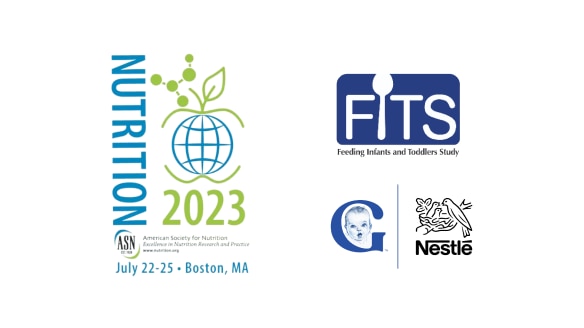FITS Data on Breastfeeding & Iron Intake
3 min read • By: Gerber Medical Hub

Test Your Knowledge
What is the top complementary food source of iron and other essential vitamins and minerals for infants?
- Mixed Dishes and Meats/Protein
- Vegetables
- Infant Cereals
- Fruits
- None of the above
c. Infant Cereals
According to data from the Feeding Infants and Toddlers Study (FITS) 2016, 18% of all infants between 6-12 months fall short of the Estimated Average Requirement (EAR) for iron (Bailey et al, 2016 ).
Starting around 6 months, infants need iron from foods to meet their iron needs and ensure adequate iron intakes to minimize the risk of iron deficiency and associated developmental delays. Based on NHANES data, 15.1% of children 1-2 years of age are iron deficient (Gupta, 2017). And while meats and some vegetables are rich in iron, Abrams et al showed that about 4% of infants 6-12 months of age are consuming. In contrast, infant cereal consumption was the top food source of iron at 34% for this critical age group. Additionally, a 2020 study by Finn et al revealed the following findings:
- Nearly all breastfed babies (96%) and most mixed fed babies (70%) who do not eat infant cereal fall short on iron in their diet.
- When breastfed babies eat infant cereal, they do much better for iron intake. Only 19% of breastfed babies consuming infant cereal not getting enough iron.
- When mixed fed babies eat infant cereal, very few fall short on iron intake (5%).
The Dietary Guidelines for Americans also recognize that infants who are primarily breastfed need infant cereal to help meet their iron and zinc needs.
As the US continues to make advances in increasing the prevalence of breastfeeding in the US, iron-rich complimentary food sources are more important than ever. Therefore, it is important for healthcare providers to recommend iron-rich foods like infant cereal for both breastfed and formula fed infants.
Additional articles and references
- Breastfed and mixed fed infants who do not consume infant cereal are at risk for inadequate iron intake: data from the feeding infants and toddlers study 2016, a cross-sectional survey
- A Substantial Proportion of 6- to 12-Month-Old Infants Have Calculated Daily Absorbed Iron below Recommendations, Especially Those Who Are Breastfed
- Are Breastfed Infants Iron Deficient? The Question That Won't Go Away
- Total Usual Nutrient Intakes of US Children (Under 48 Months): Findings from the Feeding Infants and Toddlers Study (FITS) 2016
- American Academy of Pediatrics - Healthy Children
- Dietary Guidelines for Americans 2020-2025
- Centers for Disease Control and Prevention (CDC)
- New dietary guidelines address infants, support healthy dietary patterns
- Food Consumption Patterns of Infants and Toddlers: Findings from the Feeding Infants and Toddlers Study (FITS) 2016
- Resources to help your families follow the new dietary guidelines: U.S. Department of Agriculture MyPlate
- US Breastfeeding Report Card 2020
- Iron status of toddlers, nonpregnant females, and pregnant females in the United States



